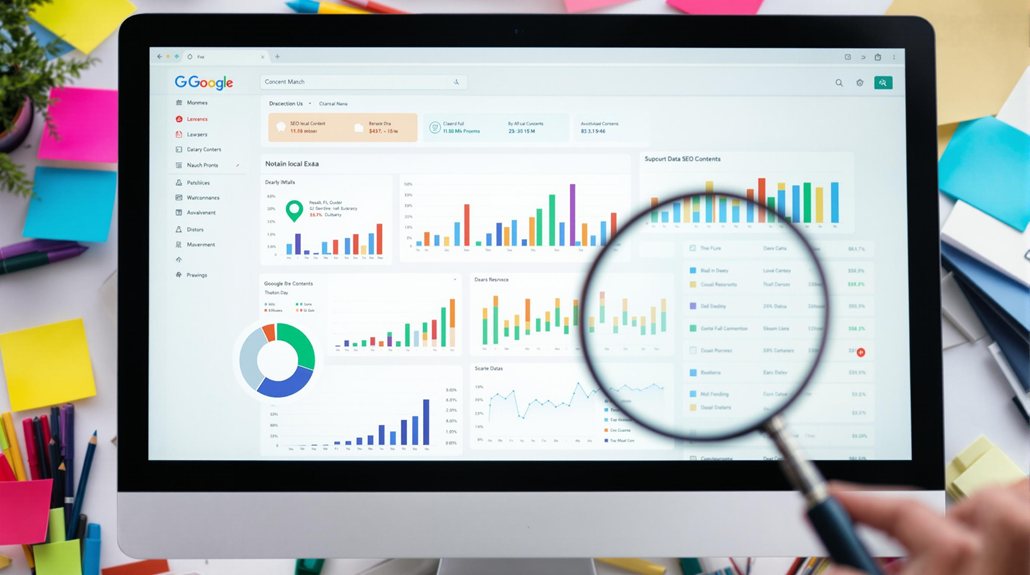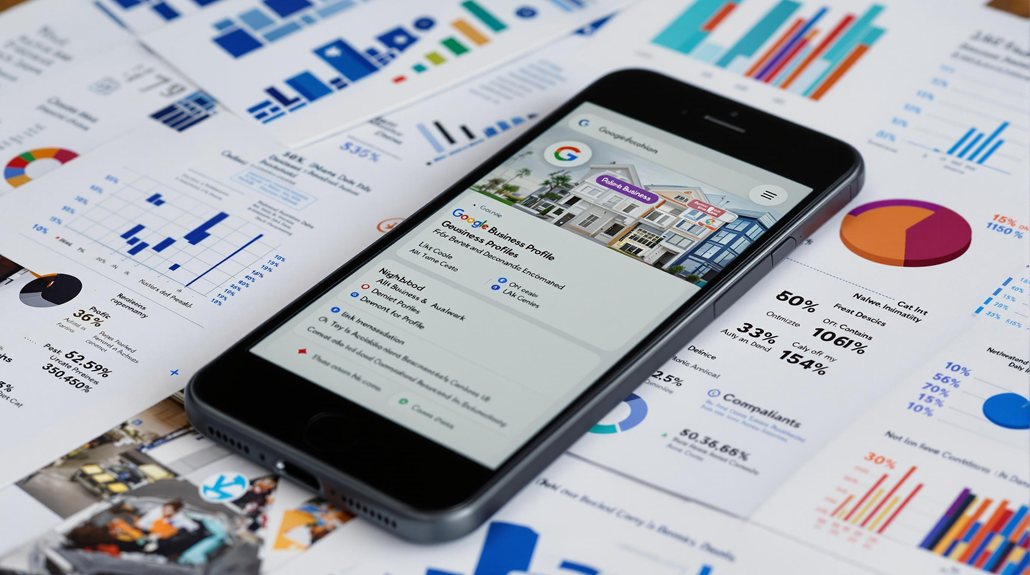Leveraging local data and statistics in your SEO content can give you a significant competitive edge. By incorporating hyper-local insights, you can create content that resonates with your target audience and drives more qualified traffic. Optimizing your Google Business Profile, building citations, and generating reviews are key local SEO tactics. Delving deeper, you'll discover how local search behavior and customer preferences can shape your content strategy for maximum impact.
The Significance of Local SEO

Why is local SEO so crucial for your business? A well-executed local SEO strategy enhances your visibility in search results, leading to higher conversion rates. Over 64% of small businesses invest in local SEO, making it a competitive necessity. Local SEO can drive significant ROI, with 40% achieving a return of 500% or better. It also helps manage your online reputation, fostering trust and loyalty among potential customers. 92% of local SEO and marketing professionals claim to have experimented with ChatGPT. To succeed, focus on optimizing your Google Business Profile, building consistent citations, creating location-specific content, acquiring local backlinks, and generating high-quality reviews. Leveraging local data and statistics in your SEO content is key to outperforming competitors and attracting nearby customers.
Trends in Local Search Behavior

The data suggests local search behavior is evolving rapidly. Consumers are increasingly relying on "near me" queries and mobile devices to find and engage with nearby businesses. 46% of search queries have local intent Capitalizing on this trend requires optimizing for immediate purchase intent and local online visibility. Consumers are also turning to alternative review platforms like Instagram and TikTok to research local businesses.
Surging "Near Me" Searches
The rise in "near me" searches underscores a heightened consumer interest in local services. With a staggering 500% growth and over 1 billion monthly searches in the U.S., businesses can't ignore this massive potential audience. 46% of all Google searches have local intent, and what's more, 76% of users visit a relevant business within a day, and 28% of these searches lead to purchases. To capitalize on this trend, optimize your Google My Business listing, incorporate location-based keywords, and ensure mobile-friendly design. Stay on top of updates, and leverage structured data to enhance your local SEO visibility. By harnessing the power of "near me" searches, you can gain a competitive edge and drive more foot traffic.
Growing Preference for Immediacy
Searches indicating immediate needs, such as "open now," have become increasingly prevalent, reflecting users' desire for quick access to local services. Around 46% of Google searches include local intent, signaling preferences for nearby businesses. A whopping 28% of local searches result in a purchase, showing urgency in decision-making. In fact, 76% of users visit a business within 24 hours of searching, highlighting the need for rapid action. Moreover, over 1.5 billion physical locations are visited monthly due to Google searches, underscoring the impact of immediate local information. Searches like "open now near me" bring up Google Business Profiles in SERPs, allowing users to quickly see opening hours and click through to Google Maps for directions. Staying agile to these evolving trends is crucial for businesses seeking visibility and conversions.
Increased Mobile Purchase Intent
As users increasingly desire immediate access to local services, their search behaviors on mobile devices have shifted towards higher purchase intent. Four in five consumers now conduct local searches with the intent to buy, and these mobile queries have surged 500% in the past two years. Over three-quarters of local mobile searches lead to an offline purchase, with half of searchers visiting a local business within 24 hours. Businesses that maintain a complete Google Business Profile have a 50% higher chance of being considered by customers for future purchases. The growing preference for immediacy and convenience has made mobile a crucial channel for reaching customers at the point of purchase decision. Local businesses must optimize their digital presence to capitalize on this heightened purchase intent among mobile searchers.
Leveraging Google Business Profiles for Local SEO

Optimizing your Google Business Profile is crucial for boosting local visibility. Ensuring your business information is accurate and consistent can significantly improve your credibility and ranking. Securing top 3 Google search results is essential for local businesses. Leveraging features like reviews and community engagement can further enhance your local SEO efforts.
Optimizing Business Profiles
If you want to maximize your local search visibility, optimizing your Google Business Profile should be a top priority. Completing your profile with all relevant details, including a compelling description under 70 words, is crucial. Ensure consistent NAP (name, address, phone) across the web, as this aids Google's understanding of your business. Businesses with over 200 reviews are more likely to appear in the top 3 SERP positions. Prioritize gathering high-quality reviews, as businesses with over 200 reviews tend to rank higher. Enhance your profile with visual content – top performers have over 250 images. Carefully select your primary category, as it significantly impacts local rankings. Regularly update your profile to reflect changes and leverage features like posts and offers to engage customers.
Verifying Profile Accuracy
Verifying the accuracy of your business profile is paramount, as Google prioritizes verified listings in local search results. Verification establishes business credibility and legitimacy on Google. Ensuring consistent name, address, and phone number (NAP) across all directories is crucial. Additionally, properly categorizing your business and defining your service area are key to improving visibility. Consider the following methods for verifying your profile:
| Method | Description |
|---|---|
| Postcard Verification | Google sends a verification code by postcard. |
| Phone Verification | Automated phone calls for eligible businesses. |
| Email Verification | Verification through email for some businesses. |
| Instant Verification | Available for businesses already verified in Google Search Console. |
| Mass Verification | Option to verify multiple locations at once using a form. |
Maintaining accurate and up-to-date business information is essential for leveraging the benefits of a verified Google Business Profile. [Unverified businesses lack full visibility in search results and on Google Maps.
Leveraging Local Visibility
Given the importance of local visibility in SEO, you'll want to leverage your Google Business Profile to its full potential. With over 1,200 monthly views on average, a complete and optimized profile can significantly boost your online presence. Businesses with a verified profile are 94% more likely to be seen as reputable, and complete profiles are seven times more likely to get clicked. Leverage relevant keywords, your primary category, and your proximity to the searcher to improve local pack rankings. Enhance your profile with photos, reviews, and local-specific content to drive higher engagement and conversions. 42% of local searches involve clicks on the Google Map Pack, making a well-optimized Google Business Profile crucial for local visibility.
Insights Into Customer Behavior in Local Search
As a local business owner, you'll want to pay close attention to the insights into customer behavior in local search. The data shows that 80% of U.S. consumers search for local businesses weekly, with 32% doing so daily. Local consumers rely heavily on mobile devices to conduct these local searches and find nearby options. When discovering businesses, 72% rely on Google, while platforms like Instagram, Yelp, and Facebook also play a significant role. Crucially, 76% of customers check online reviews, which directly impact rankings and purchase decisions. Maintaining accurate information and a strong online presence are essential to attracting and retaining local customers.
Incorporating Keyword Research for Local SEO
Conducting thorough local keyword research is crucial for optimizing your content and improving visibility in local search results. By leveraging tools like Semrush's Keyword Magic Tool, you can identify relevant local keywords with valuable search volume data, allowing you to tailor your content to the needs of your local audience. Additionally, analyzing search intent and incorporating location-based modifiers can further enhance your local SEO strategy. Finally, monitoring your competitors' local keyword tactics and evaluating key metrics like search volume and keyword difficulty will enable you to make informed decisions and stay ahead of the competition.
- Identify Relevant Local Keywords
- Analyze Search Intent for Local Queries
- Leverage Location-Based Modifiers
Optimizing Local SEO Through Content Strategies
Optimizing local SEO through content strategies is paramount for businesses seeking to reach their target audience. By creating relevant local content, you can leverage long-tail keywords and position your brand as an expert in your field. Engage local audiences through blog posts on popular topics, demonstrating your expertise and building trust. Utilize local search trends, such as "near me" queries, to enhance your visibility. Measure the success of your local SEO efforts by tracking metrics like website traffic and conversion rates. Optimize your blog content with location-specific details, internal links, and clear calls-to-action to guide users through your marketing funnel. Consistent, high-quality local content can significantly impact your online presence and bottom line.
Analyzing Competitor SEO Tactics for Local Visibility
Identifying your local SEO competitors is the crucial first step in analyzing their tactics for boosting visibility. Assess their strategies across these key areas:
- Google Business Profile Optimization: Evaluate how competitors leverage their profiles, including category selection, review management, and posting frequency.
- On-Page SEO: Examine their title tags, meta descriptions, content quality, and mobile responsiveness to uncover optimization opportunities.
- Local Backlink Portfolio: Identify the high-quality local links that contribute to their rankings and explore ways to replicate or outperform their link building efforts.
Staying Ahead of Local SEO Trends
How can you stay ahead of the ever-evolving local SEO landscape? Optimizing for mobile, leveraging AI, and analyzing local statistics are key. Ensure your Google Business Profile is fully optimized and your website is mobile-friendly. Incorporate voice search strategies and location-specific content. Utilize AI to automate tasks, analyze competitors, and enhance data-driven decision-making. Recognize the power of local search, with 46% of Google queries being local and a 500% ROI for local SEO campaigns. Optimize content for local relevance, build customer reviews, and stay agile to thrive in the dynamic world of local SEO.
| Mobile Optimization | AI Integration |
|---|---|
| Google Business Profile | Predictive Analytics |
| Mobile-Ready Websites | Personalized Campaigns |
| Voice Search Integration | Competitor Analysis |
| Location-Specific Content | Efficient Data Analysis |
Small Businesses Investing in Local SEO
As a small business owner, you know the power of local SEO. By optimizing your Google Business Profile, conducting keyword research, and creating location-specific pages, you can enhance your online visibility and capture more of your target market. Additionally, leveraging structured data, building high-quality backlinks, and managing your online reputation can further boost your local SEO efforts and drive tangible results.
Strategies for Local SEO
Small businesses looking to invest in local SEO should first focus on establishing a robust online presence. This includes creating and verifying a Google Business Profile, optimizing website content with relevant local keywords, and ensuring your website is mobile-friendly.
To build local authority, consider these strategies:
- Leverage partnerships and guest blogging opportunities to secure valuable local backlinks.
- Participate in community events and showcase your involvement through content.
- Utilize local SEO tools like rank trackers and website graders to monitor progress and identify areas for improvement.
Regularly measuring the ROI of your local SEO efforts and refining your tactics based on data-driven insights will be critical for long-term success.
Maximizing Local SEO Investment
Though small businesses may face unique challenges when investing in local SEO, maximizing your return on investment (ROI) is crucial for driving long-term growth. With up to 40% of local SEO campaigns achieving a 500% or better ROI, this marketing strategy offers significant revenue potential. Ensure your website is mobile-friendly and prioritize building a positive online reputation, as 78% of mobile local searches result in offline purchases. By optimizing for the local pack and leveraging high-performing content, you can boost visibility and conversion rates. Local SEO also provides sustainable results, offering long-term value without ongoing advertising expenses.
Missed Opportunities for Businesses Lacking Local SEO
Failing to implement a robust local SEO strategy equates to missed opportunities for businesses that serve physical locations. Without a local SEO presence, you miss out on high-converting traffic, as local searches often lead to immediate purchases. Additionally, the absence of a Google My Business listing is a significant oversight, as it is a top local SEO ranking factor. Moreover, not investing in local SEO can lead to inaccurate business listings, negatively impacting your search engine rankings. Ultimately, over half of companies do not optimize for local search, reducing their visibility and competitiveness in local markets, which you cannot afford to overlook.
- Missed out on high-converting traffic from local searches
- Significant oversight by not having a Google My Business listing
- Inaccurate business listings due to lack of local SEO investment
Driving High-Quality Leads With Proper Local SEO
Proper local SEO strategies can drive high-quality leads to your business. With 80% of local mobile searches converting into meaningful actions, you can't afford to overlook the power of local SEO. By optimizing your Google Business Profile, you'll boost your visibility and increase your chances of being considered for future purchases. Incorporate location-specific keywords and high-quality, valuable content to establish your authority. Securing relevant backlinks and monitoring your analytics will further enhance your local SEO efforts. Don't let your competitors outrank you – invest in local SEO and watch your conversion rates soar.
Connecting With the Target Audience Through Local SEO
Local data and statistics can help you optimize your local visibility, tailor your content to your customers, and leverage location-based insights to connect more effectively with your target audience. By understanding the local search trends and preferences of your potential customers, you can create a local SEO strategy that resonates and drives meaningful engagement. Leveraging these insights can give you a competitive edge and position your business as a trusted local resource.
Optimizing Local Visibility
Why is optimizing local visibility crucial for connecting with your target audience through local SEO? Improving local visibility allows you to:
- Rank Higher in Local Search Results: Targeting relevant local keywords and optimizing your business listings can boost your rankings in local search results, making it easier for nearby customers to find you.
- Showcase Your Proximity: With location-based searches being a key ranking factor, showcasing your proximity to the searcher's location can attract more qualified leads who are ready to visit your business.
- Manage Your Online Reputation: Monitoring and responding to customer reviews helps you maintain a positive online reputation, which can significantly influence purchase decisions for local consumers.
Tailoring Content to Customers
Although local SEO is crucial for connecting with your target audience, tailoring your content to their specific needs and preferences is equally vital. By understanding local search behavior, you can craft engaging, locally-relevant content that resonates with your customers. Consider using high-volume, low-competition local keywords, long-tail location-specific terms, and optimized meta tags and descriptions to enhance your content's discoverability. Furthermore, focus on providing informative, valuable content that adds unique value to local users. Engage your audience through interactive content, responsive design, and personalized messaging to build trust and foster stronger connections.
| Local Search Platforms | Interactive Content | Responsive Design | Tailored Messages |
|---|---|---|---|
| Google, Google Maps, Yelp | Reviews, Questions | Accessible across devices | Location-specific keywords |
Leveraging Location-Based Insights
As local search continues to evolve, leveraging location-based insights can be a game-changer in connecting with your target audience through local SEO. With 46% of monthly Google searches having local intent, optimizing for location-specific keywords and creating relevant landing pages are crucial. Additionally, 86% of people use Google Maps to find business locations, emphasizing the importance of maintaining a strong local presence. Moreover, 28% of local searches result in a purchase within 24 hours, highlighting the immediacy of local intent and the potential for fast conversions.
- Perform in-depth local keyword research to identify relevant search terms.
- Create location-based landing pages to increase relevance for specific geographic targets.
- Regularly update content to align with changing local search trends.
The Impact of Local SEO on Business Decision-Making
The impact of local SEO on business decision-making cannot be overstated, as it directly influences the visibility, credibility, and ultimately, the success of local enterprises. With 46% of searches having local intent, businesses must optimize their online presence to be found by potential customers. 90% of consumers make a purchase within a week after searching for a local business, highlighting the importance of a strong local SEO strategy. Moreover, 64% of small businesses have embraced local SEO, recognizing its ability to provide the best marketing ROI. By leveraging local data and statistics, businesses can make informed decisions to enhance their online visibility and drive customer engagement.
Mobile Searches and Immediate Purchase Decisions
Mobile searches are becoming increasingly influential in driving immediate purchase decisions. According to the data, 92% of consumers who use a smartphone to research a product or service make a purchase within a day. Furthermore, 77% of smartphone shoppers are more likely to purchase from companies whose mobile sites or apps allow them to make purchases quickly. Additionally, mobile searches related to "same-day shipping" have grown over 120% since 2015, indicating a growing consumer demand for fast and convenient purchasing options. Businesses that optimize their mobile presence and cater to these mobile-driven purchase behaviors are poised to gain a competitive advantage.
- 92% of consumers who use a smartphone to research a product or service make a purchase within a day.
- 77% of smartphone shoppers are more likely to purchase from companies whose mobile sites or apps allow them to make purchases quickly.
- Mobile searches related to "same-day shipping" have grown over 120% since 2015.
The Power of Reviews and Ratings in Local Search
While mobile searches have become instrumental in driving immediate purchase decisions, the power of reviews and ratings in local search cannot be overstated. Positive reviews significantly enhance visibility in local search results, with 56% of consumers preferring businesses with positive reviews. Online reviews account for 15.44% of how Google ranks a local business, and a one-star improvement in Yelp rating can lead to a 5-9% increase in revenue. High star ratings increase click-through rates and influence consumer perceptions, with a 3.7-star rating boosting conversion rates by 120%. Regular, keyword-rich reviews provide fresh content, improve user engagement, and strengthen brand credibility, making reviews essential for local SEO success.
